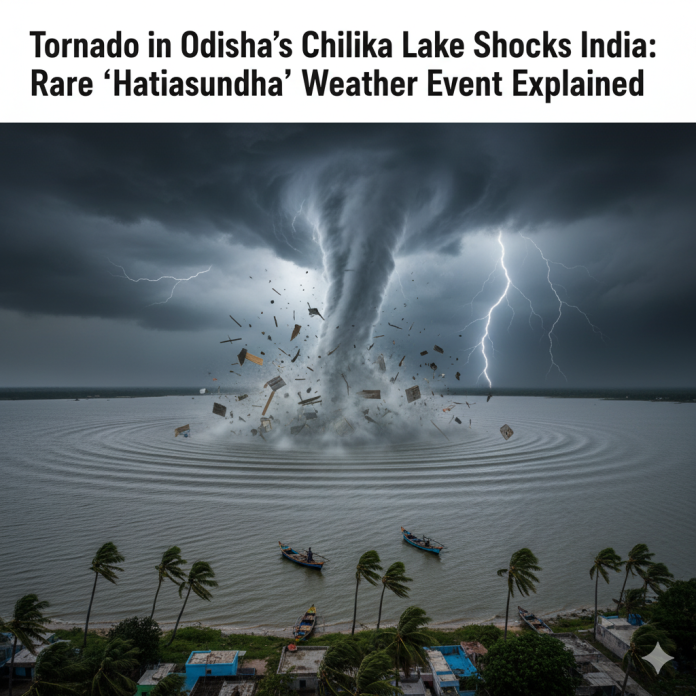Odisha, India (October 11, 2025):
A rare and powerful tornado formation over Chilika Lake in Odisha has captured the attention of the entire nation. The massive swirling column of air, shaped like an elephant’s trunk, was spotted on Friday afternoon, stunning locals and sending panic among tourists who were on boat rides in the area.
The phenomenon — locally called “Hatiasundha” — is rarely seen in India, especially over a large brackish water lagoon like Chilika. Videos of the tornado went viral on social media platforms such as X (formerly Twitter), Instagram, and WhatsApp within minutes, showing a dark funnel cloud stretching from the sky down to the lake’s surface.
Witness Accounts: “We Saw Water Rising Like a Pillar”
Eyewitnesses described the tornado as a “giant water pillar spinning rapidly”, moving across the lake for nearly 15 minutes before dissipating.
“We were taking tourists near Kalijai Island when the sky suddenly turned dark. Then we saw a funnel touching the water surface. It started moving and created strong waves,” said Ramesh Behera, a local boatman.
Many tourists were seen rushing back to the shore as gusty winds picked up speed. The Odisha Tourism Department confirmed that no casualties or damage were reported, but the event caused temporary chaos as people fled boats and viewing platforms.
What Exactly Happened: The Science Behind the ‘Hatiasundha’ Tornado
Meteorologists at the India Meteorological Department (IMD) explained that the formation was a waterspout, which is essentially a tornado occurring over water. These are rotating columns of air and mist that connect a cumulus cloud with the water surface.
According to IMD scientist Dr. M. K. Sahu,
“This was a non-supercell tornado, a type of weather vortex that can form during high humidity and unstable atmospheric conditions over warm waters. The temperature contrast and sudden wind shear triggered this rotating updraft.”
Waterspouts are not common in India’s climate, but Chilika Lake’s unique geography, combining warm, shallow waters and sea-air interaction, creates favorable micro-conditions for such formations during monsoon withdrawal.
Where and When It Happened
- Date: October 10, 2025
- Time: Around 3:30 PM (IST)
- Location: Southern region of Chilika Lake, near Kalijai Island, Odisha
- Duration: Approximately 12–15 minutes
- Maximum Estimated Wind Speed: 100–120 km/h
Local fishermen and tour operators captured videos showing the funnel touching the lake, lifting water, and forming a white mist trail as it spun.
IMD’s Statement and Early Reactions
The Bhubaneswar Meteorological Centre released a statement confirming the tornado-like formation, emphasizing that it was a “localized atmospheric event” and not a sign of a major cyclone.
“We urge the public not to panic. This is not a sign of a larger weather system like a cyclone. It’s a rare but natural phenomenon,” said Dr. U. S. Dash, Director of IMD Bhubaneswar.
The IMD has also begun analyzing satellite and Doppler radar data to study the tornado’s exact structure, origin, and wind velocity. Preliminary findings suggest that the tornado was triggered by a strong updraft and localized convection zone over the lake area.
Social Media Flooded with Tornado Videos
Within hours, social media platforms were flooded with dramatic visuals of the tornado. Hashtags like #ChilikaTornado, #OdishaWeather, and #Hatiasundha trended across X (Twitter) and YouTube.
One clip showing a funnel cloud rotating violently over the lake gained over 5 million views in less than 6 hours. Another video, shared by a tourist from Bhubaneswar, captured the sound of gushing winds and panicked voices saying, “It’s coming closer!”
The visuals, though terrifying, also fascinated weather enthusiasts, many of whom called it a “rare glimpse of nature’s power.”
How Rare Are Tornadoes in India?
While the United States is known as the global “tornado hotspot,” India also experiences tornado-like events occasionally — mostly in coastal and northeastern regions.
According to IMD records, the last significant tornado in India occurred in March 2023 in West Bengal, which damaged several villages near Hooghly. Before that, Assam and Andhra Pradesh recorded short-lived tornadoes over rivers and coastal areas.
However, a tornado over a large inland lagoon like Chilika is exceptionally rare. Experts say that climate change and shifting weather patterns might be contributing to such anomalies.
Experts Warn of Changing Weather Patterns
Climate researchers have expressed concern that increasing sea surface temperatures and atmospheric instability could lead to more unpredictable weather events in the coming years.
“We are seeing atmospheric dynamics changing faster than predicted. Warmer waters in the Bay of Bengal are increasing the potential for rotating storms, water spouts, and even inland tornadoes,” said Prof. A. K. Mishra, a climate scientist from Utkal University.
He added that while India may not face frequent tornadoes like the U.S., micro-storms and localized weather extremes could become more common.
Government and Disaster Response
After the viral videos surfaced, the Odisha State Disaster Management Authority (OSDMA) and local district officials issued an alert advising fishermen to avoid venturing into Chilika Lake until further notice.
The Marine Police deployed boats to monitor the area, ensuring that no vessels were stranded during the storm. Tourism officials also reviewed emergency protocols for tourist boats operating in Chilika.
The Chief Minister of Odisha, Naveen Patnaik, praised local authorities for their swift response and reassured citizens that the event was “isolated and under control.”
Impact on Tourism
Chilika Lake, known for its breathtaking beauty and migratory bird population, is a major tourist attraction in Odisha. October marks the start of peak tourist season, with thousands of visitors arriving for boat rides and bird-watching.
The sudden tornado caused temporary disruption. Boat services were suspended for a few hours but resumed after safety inspections were completed.
Tourism officers reported that although no damage occurred to boats or infrastructure, many tourists cut short their trips, fearing more extreme weather.
“It was a frightening experience, but also awe-inspiring. We never imagined we’d see a tornado in India,” said Pooja Sharma, a visitor from Delhi.
How Tornadoes Form: A Simple Explanation
Tornadoes form when warm, moist air near the surface meets cold, dry air above, creating instability. When wind direction and speed change sharply with height — known as wind shear — it causes air to start spinning horizontally.
An updraft (rising warm air) tilts this spinning air into a vertical column, forming a funnel cloud. When it touches the ground (or water), it becomes a tornado or waterspout.
In the case of Chilika, warm surface water, high humidity, and afternoon heating likely combined to create the perfect conditions.
Historical Perspective: India’s Past Tornado Events
Though rare, India has faced a few notable tornadoes:
| Year | Location | Description |
|---|---|---|
| 1838 | Calcutta (Kolkata) | One of India’s earliest recorded tornadoes — caused widespread destruction. |
| 1978 | Cooch Behar, West Bengal | Killed 120 people; one of the deadliest tornadoes in Indian history. |
| 1998 | Assam | Tornado crossed the Brahmaputra River, destroying hundreds of homes. |
| 2023 | Hooghly, West Bengal | Viral videos captured a small tornado tearing through farmland. |
| 2025 | Chilika Lake, Odisha | First major recorded waterspout tornado over India’s largest lagoon. |
Why Chilika Is a Unique Weather Zone
Chilika Lake spans over 1,100 square kilometers, making it Asia’s largest brackish water lagoon. It connects with the Bay of Bengal through narrow sea mouths, allowing warm, moist sea air to interact with cooler inland air.
This dynamic interplay often produces localized weather activity, including intense thunderstorms, heavy rain bursts, and occasionally, waterspouts like this one.
According to the Odisha Weather Observatory, wind patterns around the lake can “amplify rotation” under certain conditions — explaining why this tornado developed so quickly.
Safety Measures During Tornado-Like Events
Although tornadoes are rare in India, here are some important safety guidelines shared by the National Disaster Management Authority (NDMA):
- Move indoors immediately — preferably into a concrete building.
- Stay away from windows and open areas.
- Avoid boats and water bodies.
- Don’t shelter under trees or temporary structures.
- Listen to local weather alerts via radio or phone updates.
- Tour operators should suspend boat rides during thunderstorms or dark cloud buildup.
These measures have now been reinforced across Odisha’s coastal districts following the Chilika incident.
Climate and Environmental Impact
Experts are also assessing whether the tornado disturbed Chilika’s fragile ecosystem, home to over 160 species of migratory birds and endangered dolphins.
“Preliminary reports suggest no visible harm to the ecosystem,” said a Chilika Development Authority (CDA) officer. “But we are monitoring water turbidity and bird migration patterns closely.”
Environmentalists, however, warn that rising global temperatures are changing the natural rhythm of coastal ecosystems, making extreme weather more frequent.
Role of Technology in Predicting Tornadoes
India’s Doppler weather radar network, particularly at Paradeep and Gopalpur, helped capture detailed imagery of the Chilika tornado.
However, meteorologists admit that tornado prediction remains difficult, as these phenomena form and disappear within minutes.
The IMD has now proposed installing advanced radar sensors near Chilika and AI-based forecasting models to detect sudden air vortices earlier.
Public Reaction: Between Fear and Fascination
The tornado has sparked a wave of public curiosity. While some feared it was a “sign of a cyclone,” others marveled at the spectacle of nature.
Social media memes, reels, and scientific explainers have made the “Hatiasundha” a national talking point.
Interestingly, local folklore in Odisha associates “Hatiasundha” with divine signs, believing it symbolizes “Lord Jagannath’s power over the sea.”
The Bigger Picture: Climate Change and India’s Weather Future
India’s meteorologists say the Chilika tornado is a wake-up call.
With rapid urbanization, coastal degradation, and rising temperatures, rare phenomena like tornadoes, dust storms, and microbursts could become more frequent.
The Ministry of Earth Sciences is planning to include tornado tracking and research under its Monsoon Mission Program 2.0. This will help develop localized alert systems and public awareness programs in coastal areas.
Conclusion: A Reminder of Nature’s Power
The tornado over Chilika Lake will be remembered as a rare and mesmerizing moment in India’s weather history.
It brought awe, fear, and scientific curiosity — reminding us how fragile yet dynamic our planet’s systems are.
As India moves deeper into the era of climate uncertainty, such events underscore the importance of preparedness, awareness, and respect for nature’s power.
Key Takeaways
- A rare tornado appeared over Chilika Lake, Odisha on October 10, 2025.
- It lasted about 15 minutes, causing panic but no damage.
- Scientists confirmed it was a waterspout, a type of tornado over water.
- Climate experts link it to rising ocean temperatures and unstable air patterns.
- Government agencies are now studying it and updating safety protocols for tourists and fishermen.































